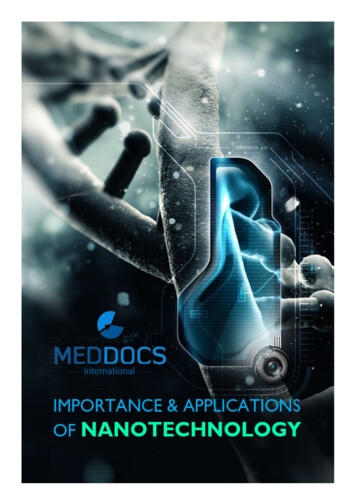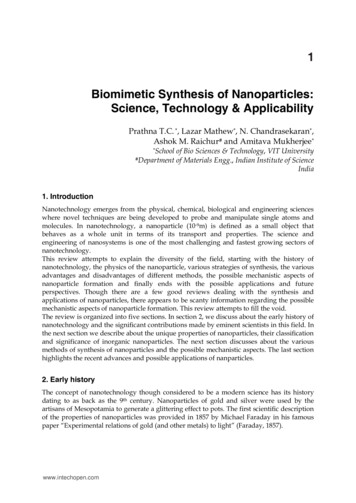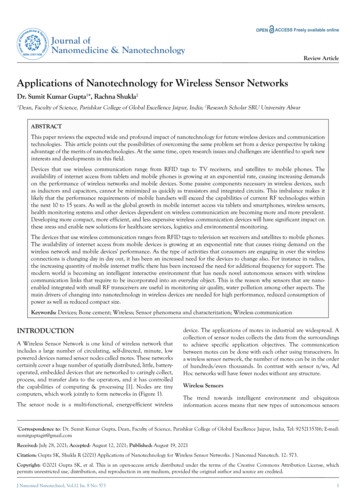
Transcription
MedDocs eBooksNanotechnology: Applications, techniques, approaches, & theadvancement in toxicology and environmental impact ofengineered nanomaterialsSumera Zaib*; Jamshed IqbalCentre for Advanced Drug Research, COMSATS University Islamabad, Abbottabad Campus, Abbottabad-22060, PakistanCorresponding Author: Sumera ZaibCentre for Advanced Drug Research, COMSATS University Islamabad, Abbottabad Campus, Abbottabad22060, PakistanEmail: sumera.biochem@gmail.comPublished Online: Jun 12, 2019eBook: Importance & Applications of NanotechnologyPublisher: MedDocs Publishers LLCOnline edition: http://meddocsonline.org/Copyright: Zaib S (2019).This chapter is distributed under the terms ofCreative Commons Attribution 4.0 International LicenseIntroductionNanoscience refers to the handling of materials, systems anddevices at atomic, molecular and macromolecular level, whereas, nanotechnology is the cluster of techniques involved in design, synthesis, characterization and application of structures,materials, devices and systems by manipulating shape and sizeat nanometer scale. At nanometer level, individual moleculesand interaction between them becomes important in comparison with the macroscopic properties of the material or device.Control at nanometer scale and manipulation of fundamentalmolecular structure permits to regulate the bulk macroscopicchemical and physical properties of the material and device[1]. The scale of dimensions is frequently 100 nm. The ideaof nano-science is credited to physicist Richard Feynman in1959, where he delivered a lecture at American Physical Society“There’s plenty of room at the bottom - an invitation to enter anew field of physics” and he explored the ideas and benefits ofmanufacturing devices, and things on the very small scale. Heanticipated the ideas that might be utilized to produce largescale integrated circuits, gene sequencing, reading DNA mol-Importance & Applications of Nanotechnologyecules, and electron microscopy for writing enormous amountsof information in very slight bits. Many of his predictions arenow well-established techniques in nanotechnology, although,he didn’t coin the term nanotechnology [2].Norio Taniguchi in 1974 used the term nanotechnology,while describing how the dimensional accuracy has improvedwith elapsing time. He was the first one to study developmentand advancements in machine technologies over three decadesfrom 1940s to 1970s. He had foreseen the development ofdimensional accuracies better than 100 nm by the era of late1980s. He employed the term nanotechnology for these futuredevelopments [3]. Initially, physicists and engineers were thepioneers of nanotechnology. They developed nanotechnologyby realizing the ideas of Feynman. He predicted the possibilities of developing technologies that might take, shuffle and rearrange an atom to make new chemical analogue. In 1981, twoscientists at Zurich, developed scanning probe microscope andwon Noble prize in 1986. In this microscope, a sharp metal head1
MedDocs eBooksscans above the surface to visualize these atoms on surface. Eigler and his group explored the basics of physical and quantummechanical phenomena using the same technique. In 1989, Eigler and his co-workers used the same technique to spell IBMon the surface of xenon atoms at temperature close to absolutezero [4]. Gimzewski worked on extreme nanotechnology, wherehe pushed single molecules around surfaces at room temperature using similar technology [5].and degradation during various phases of processing, manufacturing and storage, it also increases compatibility of differentcompounds in the system [11]. Different polymer-based encapsulation and delivery systems have been developed for betterbioavailability, conservancy of the active food components andaptitude to infiltrate deeply into tissues. It allows effectual distribution of the active component towards target point in body[12]. By nanotechnology food products have been improved interms of texture, appearance, taste, nutritional value, and theirshelf-life. Nanotechnology is responsible for significant modifications in food products as they improve the quality and enhance the taste of food. Nano-encapsulation has been broadlyused for the release of desired flavour and its retention to deliver culinary balance. Encapsulation of cyanidin-3-O-glucosidein the inner cavity of recombinant soybean seed has resultedin improved thermal and photo stability [13]. Encapsulation ofrutin with ferritin enhanced the solubility, and stability againstheat and UV radiations [14]. Lipid-soluble bioactive compoundsare formulated in nano-emulsions using natural food ingredients to enhance water-dispersion and bioavailability [15]. Ascompared with conventional methods nanoparticles improvethe bioavailability of nutraceuticals. Silicon dioxide (SiO2) is usedas colouring agent in food items. SiO2 nanoparticles are used asthe carriers of flavours in food products [16].Advancement in nanotechnologyWith the development in areas of materials science, chemistry and engineering over the previous few eras’ nanotechnology has remained exploited in all fields where insignificant sizeplays crucial part in determining fundamental properties. Theyare being used from physics, engineering, and chemistry tobiologicals and medicine. Nanoparticles of cadmium tellurideare employed in the labelling of biological molecules with precision. Nanoparticles of titanium dioxide effectively block UVradiation and they are the main component of sun screens. In1985, carbon-60 molecule was exposed by Harry Kroto, RichardSmalley and Robert Curl and they won the Nobel Prize for theirwork in 1996. In 1991, carbon nanotubes were discovered byIijima. A type of nanotechnology ‘Bottom-up nanotechnology’involves the self-assembling traits of biological systems, such asDNA molecules which control the organization and structure ofcarbon nanotubes [6].Macromolecules in the body essential for cellular haemostasis such as lipids, vitamins, proteins and carbohydrates requireoptimum pH for their activity. In addition, they are sensitive tolow pH environment. Encapsulation of these compounds helpsthem to resist acidic environment. Moreover, it allows themto integrate readily in food products. Nanoparticles-basedcapsules are formulated for significant benefits over conventional capsules [17]. Different techniques are employed in theprocess of nano-encapsulation to effectively deliver nutrients,proteins, and antioxidants and the other active compounds.Polymer based nanoparticles are appropriate for encapsulationof bioactive compounds to protect and transport the targeteddelivery [18]. Furthermore, nano-encapsulation of bioactivecomponents extend the shelf life of food materials either viareducing degradation process otherwise by preventing deprivation unless the product is transported towards target site.Nano-coatings are done on various food materials and they arefound to be effective barrier against moisture and gas exchange.These coatings are also responsible for specific colour and flavours of food product. It also effectively delivers enzymes andantioxidants, hence increasing shelf-life of manufactured foodsonce the seal is opened [19]. Encapsulating functional components retards the chemical degradation process e.g. encapsulation of curcumin exhibited condensed antioxidant activity andit was found to be stable to pasteurization and at diverse ionicstrengths [20].Nanotechnology in food processingNontechnology has been implicated in food industry for thepast decades to improve quality, taste and texture of foods,and to prevent them from pathogen infestations. Nanotechnology is employed to increase the shelf-life and improve thestorage of food materials by preventing microbial infestations[7]. Nano-carriers are now used as delivery systems for foodadditives without disturbing the basic morphology of food. Innutraceuticals, an ideal delivery system (nano-carriers) shoulddistribute the active compound precisely at specific rate on target place. Nanotechnology has become an integral part of foodprocessing and food packaging with the advent in developmentof nano-polymers. Nano-sensors have been developed for theapprehension of contaminants, pathogens and toxic materialsin food [8].Nanotechnology and food packagingA good packaging material should consume permeability for gas and moisture in addition to strength compatibility[21]. Nano-based food packaging have numerous advantagesover traditional packaging methods as they provide improvedpackaging with enhanced mechanical strength, antimicrobialfilms for pathogen detection, and barrier properties for safetystatus of food [22]. Nanocomposites are used to improve foodpackaging [23]. Organic compounds such as essential oils, organic acids, and bacteriocins are used in polymeric matrices asantimicrobial agents. However, they are extremely delicate tophysical conditions. Nanoparticles of inorganic ions provide aFigure 1: Nanotechnology in food processing and food packing [9].In food industry and medicine, encapsulation of nanoparticles give better release and efficiency in addition to maskingthe odour and bitter taste. It controls the interactions betweeningredients and the food matrix with controlled delivery of theactive agents and its accessibility at specific rate [10]. Nanoencapsulation protects food ingredients from heat, moistureImportance & Applications of Nanotechnology2
MedDocs eBookspotential antibacterial activity in low concentrations. Therefore,these nanoparticles are being used in antimicrobial food packaging. Antimicrobial packaging inhibits the growth of microbesthat can be present on the surface of food. Moreover, differentmetals like silver and copper-based chitosan, and nanoparticlesof metal oxide are already described to possess antibacterialproperty [24].in medicine and physiology, through a high grade of useful precision. Therefore, they provide a degree of integration amongtechnology and the biological system. Manipulation of drugs,active compounds and devices at nanometer scale, allows tocontrol and alter the essential properties and bioactivity of theingredients. Thus, they allow to control the solubility of drugs,controlled release, and targeted drug delivery [34].Nanocomposites and nanolaminates provide an effectivebarrier against extreme thermal and mechanical shock thereby,extending food shelf-life. Thus, nanoparticles offer nanoparticles with quality food with longer shelf-life. Many fillers arealso being used for attaining improved polymer composites.Incorporating nanoparticles in polymers has permitted to develop additional resistant packaging by minimum cost [25]. Silicate and silica (SiO2) nanoparticles, and chitosan gives polymermatrix stronger, fire resistance, and improved thermal properties [26]. Antimicrobial films are equipped by impregnating thefillers into the polymers with additional advantage due to thestructural rectitude and barrier properties [27].Nanoparticles as nanosensorsNanomaterials offer the high level of sensitivity in food microbiology. Nanobiosensors are developed to detect microbesin processing of food material, plants and for the quantification of food ingredients, alarming customers and suppliers overthe food safety status. Moreover, it acts as an indicator whichthat reacts to environmental changes in microbial contamination, storage rooms and in products degradation [28]. Variousnanoparticles and nanofibers have possible applications to useas biosensors. Optical immunosensors have extremely complexdetection systems. In these immunosensors, thin nano-films orsensor chips are loaded with specific antibodies, antigens, orprotein molecules. These chips produce signals on detection oftarget molecules. Another immunosensor was established todetect the foodborne pathogens e.g. E. coli. Immunosensor iscomposed of dimethylsiloxane integrated with specialized antibodies immobilized on nanoporous alumina membrane whichproduce electrochemical impedance spectrum on detection ofpathogen. Nanotechnology has influenced the detection techniques used for pesticides, pathogens and toxins [29].Figure 3: Multifunctional nanoparticle for molecular imaging,drug delivery and therapy [35].Different applications of nano materials and nano-medicinecomprise fluorescent biological labels, detection of amino acids,lipids and proteins, drug delivery, and other macromolecules,pathogen detection, probing of DNA structure, tumour identification and detection, and tissue engineering, MRI contrastenhancement and purification of biological molecule. Nanomachinery is crucial in designing of nano-medicine. Meticulouscontrol and manipulation of nanomachinery in cellular environment results in better thoughtful of the cellular mechanisticstudies in living cells. It also aids to develop innovative technologies towards the early finding and therapy of several diseases.Development of nano-medicine and advancement in biomedical engineering, provides a podium that effect nanoscale imaging, elucidating the molecular mechanisms inside the living cells[36]. Molecular imaging has become a very influential device toimagine molecular events underlying ailment state, often priorto its appearance. Adjunct of nanotechnology with molecularimaging offers a multipurpose stage for designing nanoprobeswith remarkable potential and enhanced specificity, sensitivityand signalling capabilities to use as biomarkers in human diseases [37].Figure 2: Nanoparticles as nanosensors [30].Nanoparticle renders molecular imaging by increased signal sensitivity, improved 3D resolution and capacity to spreaddata in biological systems at subcellular level. Simple magneticnanoparticles serve as magnetic resonance imaging contrastenhancement probes. Magnetic nanoparticles provide novelstage by adding the other functional units, fluorescence tags,macromolecules and radionuclides. They are also used in themultimodal imaging, cellular trafficking and gene delivery. MRIwith hybrid probes of magnetic nanoparticles is essentially usedto perceive target cells, record gene delivery and protein expression [38]. Positron-Emission Tomography (PET) has higherdetection sensitivity which allows the use of nanoparticles atlow concentration. Furthermore, combination of the PET withComputed Tomography (CT), could map signals to atheroscle-Biosensors based on carbon nanotubes are popular becauseof their quick recognition, simplicity and cost efficiency. Theyare used to detect the microbes, waterborne toxins, and varioustarnished products in food and beverages [31-32]. Small molecules are also detected by modified quartz crystal surfaces. Itis modified with different functional groups, amines, lipids, enzymes and polymers [33].Nanomaterials in medicineIn medicine such nano-materials are designed which interactat cellular level. They show interaction at molecular level withliving cells and tissues. These nano-materials and devices areessential products of biomedical engineering, and they are usedImportance & Applications of Nanotechnology3
MedDocs eBooksrotic territories [39]. For molecular imaging a contrast agentis always required at target site, nanoparticles encapsulatingthe contrast agent is an emerging technique to deliver into thetarget site. In imaging methods with lower sensitivity, nanoparticles are used to provide signal amplification. They are usedto carry the contrast agent into the tissues and at target area.Nanoparticles can deliver the drug in addition to contrast agent.It also allows to keep a track on the bio-distribution and therapeutic activity (theragnostic) [40]. Nanofiber-based scaffoldshave advantage because of their high porosity, surface areaand pore size distribution. These constraints are suitable for cellgrowth, division, attachment and proliferation. In addition, theyoffer a basis towards the optimization of electrospun nanofibrous framework in tissue-engineering.inhibit neuron regeneration [42]. Therefore, CNS injuries aredifficult to treat, and they cause more damage. Nano-devicesfor repairing neural tissue should be compatible with cells, andit should have excellent mechanical and electrical properties.Non-compatible materials fail to recover neuron growth andat they cause inflammation and infection. Without mechanicalproperties nano-devices do not last to regenerate neural tissue.Moreover, electrical properties control the behaviour of neurons thus allowing repair of neural tissue. Many nano materials have been developed for their use as nerve grafts to repairdamaged nerves [45].Figure 5: Nanotechnology approaches for neuronal diseases[46].Figure 4: Nanotechnology and its applications in medicine [41].Tissue engineeringSilicon probes are also employed in neuro-prosthetic devices.The use of neuro prostheses is mainly limited due to the formation of glial scar tissue around the nanomaterial as well as dueto the lack of compatibility and enough electrical and mechanical properties to promote nerve tissue repair. Although adventsin nanotechnology provides the essential platform for the development of novel and enhanced neural tissue engineeredproducts. The use of nanofibers and nanotubes provide bettercompatibility with brain cells and they also have better conductivity to boost neuron repair. Nanomaterials are also usedin stem cell therapy for nerve repair and to overcome damagecaused by brain injuries. Carbon nanotubes have excellent electrical conductivity in addition to strong mechanical properties.They also have similar nanoscale dimensions therefore they areused to guide axon regeneration in neural tissue injury [47].Nanomaterials are also used in the regeneration of soft tissues.Although other treatments, and surgery are available to treatbladder cancer, nano-materials efficiently improve bladder tissue regeneration without having major adverse effects and riskfactors associated with other treatment options [42].Regenerative medicine and tissue engineering techniquesare used to restore and improve lost functions of tissues. Thesetechniques showed the promising results in the past decadesas compared to traditional therapy [42]. Nanotechnology iswidely used in tissue engineering. As natural bone surface isnot smooth, and it comprises features that are about 100 nmacross. In the hip or knee prosthesis, nano-sized features ontheir surface minimize the probabilities of rejection. Moreover,they excite the making of osteoblasts.Nanomaterials for vascular tissue engineeringDue to increasing incidence of vascular diseases, demandfor the use of nanomaterial has also raised. Vascular grafts withbetter efficiency for damaged blood vessels are much needed.As blood vessels have layered structure, with nanostructuresnano-devices hold promise in treating vascular diseases [42]. Inaddition, they are also reported to inhibit incidence of thrombosis and inflammation, vascular cell adhesion and proliferation[43].Cancer therapyNanomedicine for neural diseasesIn cancer therapy, tumour cells are destroyed by atomic oxygen which is generated by laser. Such molecular oxygen is highlycytotoxic, and it destroys tumour cells efficiently. Dye used toproduce atomic oxygen is occupied by cancer cells, and it onlydestroys the tumour cells which are exposed to the laser radiation without affecting the normal cells. To avoid adverse effectson normal cells, a porous nanoparticle is used to enclose thehydrophobic dye molecule which prevent it from spreading toother parts of the body [48].With the advancement in nano-medicine, it is also used toheal damaged nerves and neural diseases and spinal cord injuries. Repairing spinal cord injuries and damaged nerves still posea challenge in the face of modern-day medicine. The peripheralnervous system can regenerate itself as it can divide and proliferate via Schwann cells. Though, these cells are not present incentral nervous system and nerves in CNS cannot heal themselves [44]. In brain and CNS astrocytes, meningeal cells andglial scar tissue are formed preventing axon growth and theyImportance & Applications of Nanotechnology4
MedDocs eBooksneered. TiO2 nanotubes on the surface of rat mesenchymal stemcells with the spacing of around 15-30 nm delivers optimumconditions for integrin formation, clustering, induction of cellproliferation, cell differentiation and migration of stem cells intoosteogenic lineages. Moreover, cell-based adhesion and growthis impaired on nanotubes which are 50 nm in sizes. Stem-cellnanotechnology in combination with imaging techniques atmolecular level, controlled propagation and growth of stemcells has shown promising results in the therapy of several abnormalities and disorders. Nanomaterials are used for labellingof stem cells, gene delivery, cellular differentiation, and organtransplantation. There is still gap in deciphering the pathwaysunderlying mechanism of interaction between nano-materialsand stem cells [54]. In course of cardiomyoplasty, the mechanism of action of cell therapy limits the size of infarct wounds, italso recovers feasibility of myocardium and stimulates ventricular and diastolic functions [55]. Merging of biomaterial technology and stem-cell biology has enabled to capture the eventstaking part in the manufacture, and communication of molecules for the regeneration of tissues and organs in novel clinical treatments [56]. Tissue regeneration via transplanting progenitor cells with molecular imaging techniques are extensivelyused. Where Magnetic Resonance Imaging (MRI) suggests highresolution and efficiency. Despite the marvellous therapeuticpotential of progenitor cells, there are many challenges in theway of stem cell therapy. The application of magnetic proceduresuggests excessive potential for the tissue repair and regenerative medicine. Despite all the advancements there is a lot to understand why transplanted stem cells are being rejected [57].Figure 6: Different nanomaterials applied for cancer therapy[49].Multicolour optical coding in the biological assaysWith the continuous growing research in genomics and proteomics, that assembles amassed amount of sequence data, theneed for development of high throughput screening technologies is increased. Single quantum dots of semiconductors areemployed instead of organic dyes for several bio-tagging applications. Fluorescent colours quantum dots are also combined inpolymeric micro-beads. Optical bar coding of polymer particlesin solution, is restricted by the amount of exclusive tags thatcould be produced and detected [50].Manipulation of biomolecules and cellsStem cells and nano-engineeringMagnetic nanoparticles are also used for cell separation andprobing. Mostly they are spherical in shape, while cylindricalnanoparticles could also be formed using metal electrode position to template of nanoporous alumina. Moreover, differentligands are attached selectively to various segments. E.g. porphyrins by carboxyl linkers and thiol are adhered to nickel andgold segments, respectively [58].Nanotechnology offers the elementary grounds and rootsfor regenerative medicine. Nanomaterials are used for thecontrolled delivery of DNA molecules at target area, whereas,nanofibers direct and prepare the tissue for modification of thebiosensors and nano-devices [51]. Embryonic and foetal stemcells, umbilical cord and adult stem cells are used for the generation of various therapeutically essential types of cell. Theseengineered cells are then processed for the therapy of variousgenetic and degenerative diseases. These disorders vary fromage-related defects, immune system disorders, osteoporosis,heart failure, spine injury, liver damage, arthritis, muscular, vascular disorders, neuro degenerative diseases such as Alzheimer’s and Parkinson’s disease, and aggressive tumours [52].Protein detectionProteins are essential macromolecules in the body, with important functions. To identify protein-protein interaction goldnanoparticles are routinely employed in immunohistochemistry. Furthermore, surface-enhanced Raman spectroscopyis used for the recognition and characterization of single dyemolecules. By merging these techniques in a single nanoparticleprobe, the detection limit multiplexing capabilities of proteinprobes are improved [59].Nanotechnology in diagnosticsWith the advent in the field of genomics and proteomics abnormalities and diseases are detected at the molecular level.Nanotechnology has enabled man to estimate gene expressionand amount of RNA production in the diseased and normal tissues. DNA chips based on nanotechnology are widely used tocheck gene expression. These chips have an inert support whichis responsible to carry out microarrays of 100-1000 of singlestrand DNA molecules with various base sequences. Radioactive or fluorescent labelled DNA from a tissue sample can beidentified based on its binding with base sequence onto thechip DNA [60]. The sequence of DNA molecules may also be established by drawing the sequences through nanopores in themembrane using an electric potential difference [61].Figure 7: Nanoparticle application in cancer treatment [53].stem cells are used as starting material for regenerativemedicines. stem cells can generate all cell types and tissueswith infinite growth morphology. stem cells have transformedthe regenerative medicine’s era and field. their role and involvement in cancer therapy are well established. for the alignmentof different type of stem cells, modified nanoscale surfaces aredesigned. for instance, haematopoietic stem cells, embryonicstem cells and mesenchymal stem cells have been bio-engiImportance & Applications of Nanotechnology5
MedDocs eBooksLabs-on-a-chip are used for analysing biopolymers and formanipulating cells. A nano-device known as PEBBLEs was developed to measure concentration of small ions and moleculesin living cells [62]. Nanoparticles of perfluorohydrocarbonsjoint with a lipid layer are appropriate as an ultrasonic contrastagent.mits the information to desired area. The information stored inthe chip is employed to identify and for security reasons. Theseradio labels are extensively used in public places especially atcare institutions and hospitals. Moreover, they are progressively used in the identification of patients and their samples inaddition to bar codes. Furthermore, these labels are of size likegrain of rice are accessible for skin implantation. The Food andDrug Administration (FDA) administration of US has permitted aRFID label for use in humans in 2004. Using these labels, patienthistory and record can be stored. Other than health care, theselabels have found significant role in the food and agriculturetechnologies [70].Super paramagnetic iron oxide nanoparticles are also usedtherapeutically. Nanoparticles can also behave as active substance [63]. Inside the cancer cells, metal with nanoparticlesare heated by near-Infrared (IR) Radiation or using rapidly vacillating magnetic field [64] to kill the cancerous cells. Silver nanoparticles have antiplatelet properties; thus, they have the potential to be used as future antithrombotic drugs.Future directionsActive grafts are transplants that consist of energy source likeinsulin or morphine pumps. Active implants are a type of targeted therapy where it goes directly to the target area as needed,and it may be monitored at different rates. Release of medicinein active implants is measured by biosensor that counter thephysiological parameters [65]. Retinal implants to restore thenormal vision are under the process of development. Variousresearch groups are now working on neural prostheses that enable devices to be controlled by thoughts and will of a personwearing them. In neural prostheses, several chips are fitted withelectrodes to the motor area of cerebral cortex. Here they workby registering the electrical signals connected with feelings andjudgements. These prostheses are named as brain-machineedges [66]. Active transplants are indispensable products ofmicro technology; however, nanotechnology is playing an extremely significant role in their advancement and development.Research is focused on growing their function, complex withsurrounding tissue, and biocompatible by surface modification.In case of retinal implants electrodes with a nanoporous surfaceare under development. This nanostructure rises the electrode’ssurface area, which is required for the proper signal transfer ofelectrodes to the tissues. An antiseptic layer made up of silvernanoparticles is previously in use for cochlear implants [67].The multidisciplinary arena of nanotechnology and its applicability in discovering novel analogues and manipulation ofavailable techniques may have probability to enhance healthcare. Nanotechnology has emerged as a powerful tool in modern day medicine in a relatively short time period. Therefore,nano-materials have entered in industrial production. Most ofthe applications of nanoparticle in medicine are focused on targeted drug discovery & delivery and gene therapy. In biologicalsciences, nanoparticles are substituting organic dyes which necessitate high photo-stability and innumerable abilities. Thereare few developments to the remote-control functionality ofnano-probes, like magnetic nanoparticles being used in removalof tumours from the body with the release of drug or destroyingthe surrounding area to get rid of tumour. The main tendencyin future development of nano-materials is to make them flexible for countless uses by control of signals emitted and herebyrevolving them into nano-devices. In near future, nanotechnology will embellish a critical tool against severe and infectiousdiseases. Moreover, another future perspective involves thecatalysis of biologically inspired nano - biomaterials and theirdevelopment. In this way, the functional catalysis will stimulatethe capabilities of natural tissues and organs. Current trends innanotechnology have developed to enhance the quality of human l
Jun 12, 2019 · essential products of biomedical engineering, and they are used Figure 2: Nanoparticles as nanosensors [30]. in medicine and physiology, through a high grade of useful pre-cision. Therefore, they provide a degree of integration among tec










